I currently share my life with two Siberian Huskies – puppy Lara (7 months old) and Shania (3.5 years old). Both of them are very silly, and very energetic. They love to play, explore, and hunt for earth critters.
Siberian Huskies are beautiful dogs who love people and love life. They can be great family dogs if properly trained. However, because of their high energy and high prey drive, they require a lot of daily exercise and are not to be trusted off leash. When bored, a Husky may chew, dig, and escape to look for adventure elsewhere.
Before getting a Sibe puppy, find out all you can about the wonderful nature of Siberian Huskies – the good, the bad, and the quirky.
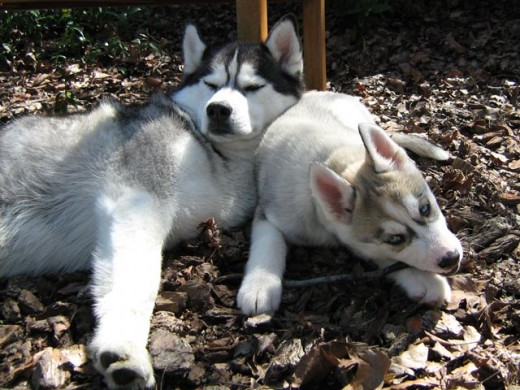
Siberian Huskies – The Good
1. Siberian Huskies are love bugs.
Sibes are very affectionate dogs. They are especially friendly with people, even strangers.
Husky Shania has very many friends in our neighborhood and she enjoys going to say hello to them every day. Her most favorite friend in the world is the Awesome Cookie Guy. Whenever we pass his house, Shania always stops and waits. When her Cookie friend spots her and comes out, he comes bearing gifts – a yummy low-fat cookie for Shania!
Shania also comes to me when I am sad or upset. She will lie down next to me or lay her head on my lap and give me licks.
The people trusting nature of Siberian Huskies make it easy to find caretakers for them when I get busy, or when I need to leave on emergencies or vacations.
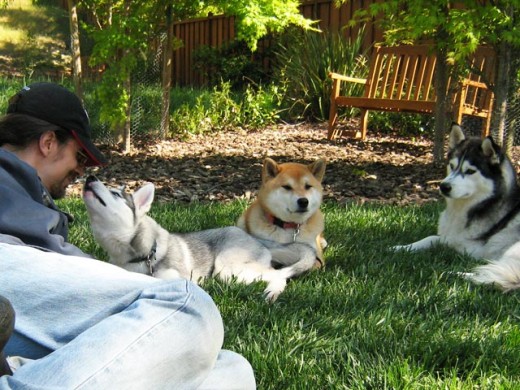
2. Siberian Huskies are athletic and have a strong zest for life.


Lara and Shania are frequently on the go. They enjoy re-landscaping our backyard, attacking bushes, pulling down trees, running, jumping, and digging. They both enjoy playing chasing games and are always ready to go out for a walk and explore. They get very excited whenever anybody comes to visit and enjoy spending play-time and rest-time with their pack.
As part of their zesty life program, Huskies also love to eat.
Both Lara and Shania will eat and eat and continue to eat more if they can. To keep them healthy and slim, I set up a fixed eating schedule and only give them their allotted amount of food. If I give them treats, then I reduce their regular meals a bit so that they keep a fairly constant caloric intake.
Sibes are not shy about stealing food or begging for food. Both Lara and Shania will steal each other’s food if they can. They will also steal from my other dog, Shiba Inu Sephy.
I always supervise them closely during meal-times. Food stealing can encourage food aggression, so I train my dogs not to steal and teach them that if there is any stealing, I will handle the situation.
Siberian Huskies can also get impatient about food and may get slightly overzealous when taking food out of your hand. Bite inhibition training is a must.
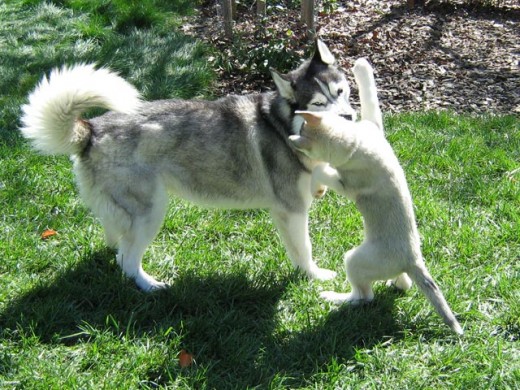
3. Siberian Huskies are clever and independent.
Reward Training
Sibes are smart and will quickly learn new commands and figure out interactive toy puzzles; especially when food is on the line.
Lara learned how to Sit on command as soon as we got her home (8 weeks old). In fact, if we use positive reinforcement techniques, we can start obedience training puppies as early as 6 weeks old. However, puppies should not be removed from the litter until they are at least 8 weeks old.
With clever and independent dogs like the Siberian Husky, it is most effective to use reward training techniques. I teach my Huskies that the best way to get what they want is to do what I want first. Here is more on how I trained my Husky puppy.

- If they want to go play in the backyard, they must first do a simple Sit next to the door.
- If they want their food toy, they must first do a Handshake.
- If they dig where they are not supposed to in the backyard then they lose their backyard privileges.
Since we control all of our dog’s resources, we can encourage good behaviors and discourage bad behaviors by tying those behaviors to our dog’s most desired resources.
With reward training my Sibes are always motivated to work. They are never hand-shy and love being with people. Siberian Huskies have a wonderful independent spirit, so we should not shock them, choke them, or physically dominate them into submission.

Siberian Huskies – The Bad
1. Siberian Huskies shed a whole lot.

Sibes blow their coat once or twice a year. During this time they will shed most of their undercoat and replace it with new fur. Frequent brushing will help to control some of this shedding and keep our Husky comfortable and clean.
Even though they may only blow their coat twice a year, Sibes actually shed all year round. There is Sibe fur everywhere in our house, including carpets, tile floor, counters, tables, chairs, blankets, and beds. Hair can also get onto kitchen utensils, food, and drinks.
Another issue to consider is pet allergies. Many people are allergic to dog or cat hair. Although Siberian Huskies have little doggy smell and are not one of the most allergy-causing breeds, a serious pet dander allergy of a family member should have you reconsidering a dog for your choice of pet.
~~[Siberian Husky Club of Canada]
Because they shed so much, try to make brushing and handling fun for your Husky. I always pair brushing sessions with food so that it becomes a fun and rewarding experience. I start with a soft brush and slowly switch over to using the Furminator which is awesome at getting out a dog’s undercoat.
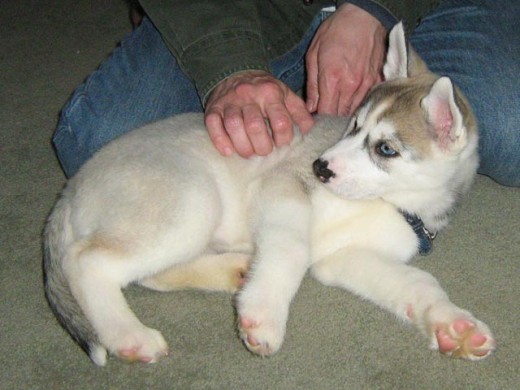
2. Siberian Huskies are awful guard dogs.

Sibes look wild, like wolves. For this reason, many people think that they make fierce guard dogs.
In truth, however, a Husky is more likely to invite strangers into your home with open paws and give them many licks.
Siberian Huskies are happy, goofy, and naturally trust all the people that they see.
My Siberians may sometimes make a fuss when people are at the door, but it is out of excitement rather than a warning cry.
Also, my Siberians will happily follow anyone home as long as they have some yummy pieces of food.

3. Siberian Huskies have very high prey drive.
Husky Shania is a very accomplished huntress.
When we first got our backyard landscaped, we had a big Earth Critter Attack. There are a fair number of rodents including gophers, voles, and mice that live in our area and they decided to throw a big party on our newly planted grass. Holes were appearing everywhere and the organic scent-based pest control we used did not seem to have much of an effect.
We were worried that our yard would not even last the year but then huntress Shania went into action. After a few days of hunting and marking, we noticed that the Rodent Gang had moved their party location somewhere else!
However, this high prey drive also makes it extremely risky to let a Sibe go off-leash in a non-enclosed space. If she spots a deer or squirrel, she will be gone and away before you can shout Stop. Siberian Huskies are very athletic and can cover large distances in a fairly short amount of time.
High prey drive also means that a Husky will have a strong instinct to chase and hunt cats and possibly also small dogs.

4. Siberian Huskies love to pull, pull, pull.


Sibes were bred to pull sleds, and today, they still love to PULL!
One of the biggest challenge with my Huskies is teaching them how to walk without pulling and/or to only pull on command.
The easiest way to leash train a Husky, is to start when she is young and still small. I have tried a variety of techniques with my dogs and what has worked best are the red-light,green-light technique and the 180-turn-around technique.
I started leash training puppy Lara almost as soon as we got her. First I trained her in our backyard. After she was fully vaccinated, I started leash training her around our neighborhood.
While leash training a Sibe, it is very important to be totally consistent. I stop as soon as puppy Lara starts to pull and if she pulls too much, I turn around and walk in the opposite direction. This teaches her that the fastest way to get to where she wants to go is to walk along with me at a measured pace.

5. Siberian Huskies love to sing.
Sibes have a great singing voice. However, neighbors may not particularly enjoy it when Siberians decide to sing or howl to the moon.
Husky Lara is a very vocal dog. She barks when excited, frustrated, scared, and sometimes when other dogs are barking. I have to spend more time and effort training her to stay quiet because her natural instinct is to vocalize.
Husky Shania is a more quiet dog. She almost never barks and the only time she vocalizes is when she is playing with my other dogs. She also sings beautifully when she hears a squeaky toy.
My Husky breeder tells me that there are some Sibe bloodlines that are more noisy than others. Lara’s mother, for example, comes from a more vocal bloodline.

6. Siberian Huskies are a big time commitment.

Sibes are very energetic and affectionate. They like being with people and they also need something to do. Otherwise, they will get bored and get into at least 10 kinds of trouble.
All my dogs work for all of their food, either through obedience exercises, grooming sessions, play sessions, or through interactive food toys. In addition, they go for 1.5 hour daily walks and wrestle with each other several times a day. Sometimes, I join in on the fun and play flirt pole or the water hose game with them.
When bored or lonely, a Husky will figure out her own activities, which may lead to property damage or escape expeditions.
Do not get a dog, especially a Siberian Husky, unless you have a lot of free time to spend with her. If you must work long hours, consider dog daycare or hiring a dog walker. Sibes do best when there are many interesting activities throughout the day and frequent human supervision.

I Love Siberian Huskies
Sibes are awesome dogs. They are always ready of adventure, and they will be there to give you licks and support when you need it, or even when you don’t.
I got my Huskies through the breeder list from the Siberian Husky Club of America. I also considered adopting from my local Siberian Husky rescue, but did not find one that fit well with my Shiba Inu.
It is best to avoid backyard breeders, pet stores, and online pet stores. Such establishments almost always sell unhealthy puppies with poor temperaments.
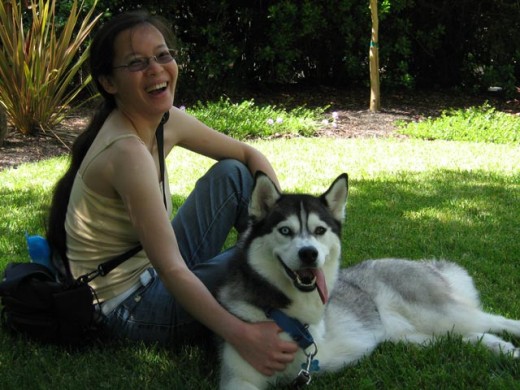
Source: Siberian Husky Pictures.
Hi. I was wondering at what age is it best to get my husky, Sterling, neutered? My vet said at 1 year, but I have other dogs ( not huskies) and they were all neutered/Spayed at 6 months. Does it really matter? And do you think it will change him a lot? I love the way he is now but I guess it would be nice if he stopped jumping so much. Thanks!
I usually find a good vet and then go with my vet’s recommendation. He has first-hand knowledge of my dog, the medical training, as well as my dog’s medical history. When I have concerns about risks, I talk to my vet about it and ask him many questions. If I am unhappy about the answers, I push him for better answers. If I am still concerned at the end, I get a second opinion from another vet.
Both my Huskies are females and I think we did their spay at around 4-6 months. With Shania, we had to delay the spay a bit because she had to go through surgery for her leg earlier on, so each situation may be different. I didn’t notice any change in their temperament after spaying. My Shiba Inu is male, and I didn’t notice any change in temperament from him either after neutering.
According to the ASPCA –
Your website really helped my wife and i train our husky puppy. I have a question on his recent habits however. Our 4 month puppy used to love sleeping in his crate but now he seems not to enjoy his crate as much as he is used to. Any suggestions for us to get him to enjoy his crate again?
Congratulations on your new family member!
What helps with my puppy is to do some her favorite activities in her crate-
1. I give her special treats in her crate that she doesn’t get anywhere else.
2. I let her work on special chew toys in her crate that she doesn’t get anywhere else.
3. I give her affection and help her with her toys while she is in her crate.
4. At night, my puppy sleeps in a crate near my bed. In this way, she can see me and smell me.
I do this regularly and repeat this many times so that she learns to associate her crate with positive time with me and rewards.
How I desensitized my puppy to crate time in the beginning.
Big hugs to your Husky boy.
Hi. I wrote about my 6 1/2 month old husky, Sterling, not too long ago and he’s still doing very well. I just had a question about his teeth. They are fine and healthy but am I suppose to brush them often or do the bones I buy him help with cleaning them? I had a pit bull who I recently had to be put down because she had cancer and couldn’t have anymore surgeries or anything to help. I would brush her teeth but not that often. Only like once a month. Oh and pitbulls can be the sweetest most loving dogs ever if you teach them to be. That dog was a peace maker. She loved everything and everyone. Cats, all dogs, all animals in general, and all people. She even loved a squirell I raised. But back to the question, I was just curious if brushing his teeth is necessary? He eats Blue wilderness large breed puppy dry food but he will only eat it if I mix it with wet food. So its always mixed and I was wondering if that would be more of a reason to brush them. And if so what doggy tooth paste is a good one? I just want to make sure he always has good healthy teeth.
With teeth brushing, I am currently brushing every day (skipping weekends) for my Husky Lara. She seems to accumulate plaque more quickly, and her vet recommended brushing her every day. My other Husky, Shania, seems to naturally have cleaner teeth, so I brush her every other day (also skipping weekends, so MWF).
Lara is over 3 years old, and she got a teeth cleaning at the vet a few months ago. I am hoping that the increased brushing will enable us to go longer between vet cleanings, as the process is very stressful for her.
I am currently using Petrodex dog toothpaste, but I am planning to try out the CET brand one next. I like the CET tooth brushes a lot more than the Petrodex ones, so I want to try out their dog toothpaste as well.
Hello i am wanting to get a husky puppy and have been reading up on their breed for about a month now. I am still interested but I don’t have a 6 foot fence. Can the husky stay in the house while I am gone (not too long) and I am A very active person so if I am taking it for long walks and runs each day is it ok to not have a yard?
Thanks!
When I got my Shiba Inu I didn’t have an enclosed yard. This made certain things more difficult. For example, I had to take him out on-leash for every potty break, and puppies need to go quite often. My Shiba would also do zoomies (high speed running) inside the house, and not having a yard limits the type of games that I can play with him. Setting up play-dates with other dogs also becomes more difficult.
We ended up taking him to our local SPCA several times a week because they had an enclosed play-space there. However, they used the space for their own dogs and for dogs from other rescues, so it was difficult to get uninterrupted time.
We were able to keep Sephy sufficiently engaged, but it required a fair amount of extra time, effort, and management, especially for an energetic puppy.
In terms of alone time, I had to slowly train my puppy to get used to it, so that he doesn’t get anxious when I leave. I start with very short periods of alone time (seconds), and then slowly build up from there.
Hi, I currently have an 8 month old husky who absolutely loves to pull. Before I leave the house I make him sit before he can leave which he does fine. But as soon as I walk out he bolts and I try to stop but he oftens jumps around and gets caught on the leash. Once that’s all over I walk out and he pulls. I’ve tried using the red-light, green-light technique but it doesn’t seem to click with him. I’ve also tried using a head halter but he hates it, he almost escaped once from it.
Any ideas? It’s particularly embarrassing when I’m walking and I can’t seem to control him. He walks fine though if we’ve done a short sprint because he’s tired.
When my Husky was young, I would do a play session with her first, usually chasing her around the backyard + recall. This helps her get her zoomies out. Then I give her some time to calm down and we go on a walk.
When I first started leash training Lara, we did leashed walks in the backyard. This gets her used to walking with me on the leash in a low stimulus and controlled environment. Once we are good with that, I did shorter but more frequent walks outside so that both of us wouldn’t get too frustrated. 🙂
I do door manners first, and keep the leash short at the start. A short leash gives me better control and also prevents the leash from getting tangled. If she bolts out, we come back in the house and I repeat the door leaving procedure. If she keeps doing this, then I may take a break, and then try again a little later. In this way, Lara learns that
Bolting out the door = no walk,
Being calm = we start the walk more quickly.
In the beginning of a walk I am usually more strict with her. If she starts to go a bit fast, I briefly tighten the lead, which is my signal to her to slow down. If she does not slow down, then I stop walking. When we start again, I start with a short lead. If she goes into pull mode right away, then I turn around and walk in the opposite direction. After a bit, if she walks well, then we go forward again.
If she pulls again once we start moving forward, then I turn back again and we walk back for an even longer distance and so on. Ultimately, if she pulls too much, we just go home and the walk ends. Then I take a rest, and try again sometime later.
Consistency is very important in terms of leash training so every time Lara pulls, I respond in a very consistent way. In this way, she learns that-
Pulling = Move away from where she wants to go,
Pulling a lot = Walk ends,
Not pulling = Get to go where she wants to go.
If I do not consistently stop her pulling, then she will learn that sometimes when she pulls, she gets rewarded by getting to her destination much quicker. This will teach her to pull even more because the next pull may be the successful one.
In addition to stopping and turning back, I also control the length of the leash. When I need more control, I use a shorter leash. When Lara walks well, I reward her by lengthening the leash and giving her more freedom. I also make sure to reward her for walking well by giving her time to sniff around, food rewards, etc.
Pulling also depends a lot on how exciting the surrounding environment is. If there is a lot happening, Lara will get more excited and will likely pull more. When I first started leash training her, we went to more quiet areas during off hours, so that I set her up for success. The more successful walks we have, the more she got into a routine of not pulling.
In general, when I am trying to change my dog’s behavior, I try to manage the surrounding context so as to maximize success, e.g. play session + recall before, door manners, shorter lead in the beginning, shorter but more frequent walks, low stimulus environment. In this way, we have more successful walks, which helps us both build confidence, and then we can slowly build up from there.
Hope this helps. Big hugs to your Husky boy!
Thank you so much for your advice, worked wonders on the first go. He was much easier to control and slowly got better at not pulling.
Hi! I basically rescued my Siberian Husky a little over a week ago, and she just decided to kill one of our chickens. I see you know what you’re doing and have some experience with training. Is there anything you could suggest to help me train her to not kill them? She has never been around them until I got her. She was chained up and left outside. Very skinny. Because of t t he pfevious owners poor care, she will be 2 around November 15, and she has already had two litters of puppies.
Four paws up for rescuing a Husky in need.
Both my Sibes have high prey drive, so it is part of their instinct to chase cats, squirrels, and more. I don’t have any chickens or house cats, but here are two articles that I like on how to train a dog not to chase cats/chickens/etc.
http://drsophiayin.com/blog/entry/how-do-i-train-my-dog-to-stop-chasing-the-chickens-cat-rat
http://www.patriciamcconnell.com/theotherendoftheleash/chase-this-not-that
i have a 4 year old husky named sasha. she was so well behaved. we bought her at 10 weeks and she was hand shy. she bonded with my pitbull calypso and formed a pac. unfortunately calypso died and we had to replace her with akasha, a blue nose pit. sasha gas accepted her but lost all training. she escapes no matter the attention or exercise she gets. forgot commands and everything. i love her and she loves akasha let her chew on her ears plays gentle with her. could this be a lashout at the missing dog? how would i retrain her. please get back to me. e-mail would be the best.
When my dog’s environment changes in a significant way, he can get very stressed and anxious. As a result of this, his behavior may change.
Some things that help with my dog when this occurs –
1. I set up a very fixed routine and consistent rules. I try to create as much certainty as possible, so that my dog knows exactly what to expect every day. Certainty helps to reduce his anxiety.
2. I increase my dog’s daily exercise and take him to calm, quiet, relaxing trails. This provides him with a positive outlet for his anxious energy, and also helps him to relax.
3. I supervise more and spend more time with my dog so that I can re-establish rules and structure in the changed environment. I follow the Nothing in Life is Free program with all of my dogs.
4. My dog is also very sensitive to the energy of the people around him. If I am stress and depressed, he will pick up on that and get stressed himself. When I control my own energy and interact with him in a calm and positive way, his behavior also got better.
What is Sasha’s daily routine like? How did you train her previously? When did the behavior change occur – was it right after Calypso passed away, when Akasha joined the household, or something else? How long has this been going on? What things have you tried?
More on dog anxiety.
Dog behavior is very context dependent, so each situation and each dog is different. When in doubt, it was helpful for me to consult with a professional trainer.
Hi,
Firstly a big hi to Lara and Shania, they are adorable, and thank you so much for the post, it is really helpful. I wanted an advice from you regarding my newest family member Ivy, she is a 7 month old siberian husky puppy.
We are five humans in the family and Lucy a 12 year old female German Spitz, now Ivy is the newest member.
Lucy has always been a very well mannered dog, she hasn’t interacted with any dog all her life (we think she believes she is a Human). She has been very shy and has never showed any form of aggression ever. We got Ivy home about a week ago and lucy was very scared of her for a couple of days, now she shows curiosity and tries to Interact with Ivy but Ivy is extremely aggressive and always bites Lucy and pulls tufts of fur off her(Lucy has a very thick coat). we have never put a collar or a leash on Lucy and both of them stay indoors. I fear where Ivy might hurt Lucy if she ends up biting her on her face. Please do advice, looking forward to your reply.
Thanks in advance
A small correction Ivy is 7 weeks old.
Dog behavior is very context dependent. It depends a lot on the dogs involved, the surrounding situation, background, and more. What do you mean by extremely aggressive? Has she drawn blood? Caused puncture wounds? Was there any food, toys, or resources around? What is Lucy’s reaction? What is Ivy’s background? What is her routine? What is her reaction to other dogs?
My Huskies love to wrestle and they play pretty rough. Tufts of fur often get left around on our carpets after play.
So it really depends on the temperament of both dogs, what Ivy is doing (is she playing, protecting something, fearful, or something else), how hard the biting is, body language of both dogs, etc. Each situation is different and it is not possible to tell without seeing things firsthand.
This is why in cases of aggression, it is usually safest to get help from a good professional trainer.
http://www.aspca.org/pet-care/virtual-pet-behaviorist/finding-professional-help
https://apdt.com/pet-owners/choosing-a-trainer/
Here is more on how I introduce a new dog to my existing dogs.
Hi, My name is Lauren and my boyfriend and I brought home a beautiful and sweet husky pup 3 weeks ago. I am curious about food… She is ALWAYS seeking food, wanting more food, and is highly motivated by food. The vet said she could gain some weight, so I increased the amount of food I am giving her, and she seems to have put on a few more pounds. However; she still acts starving. She is 10 weeks old. I am curious about how much I should be feeding her. I want her to have a healthy a sufficient calorie intake and I am wanting some clarity on the dangerous of feeding her too much. Isn’t is hard for huskies to loose weight? Anyway, trying to navigate this the best I can. Please help! Thank you so much . I love your website!!
Congratulations on your new Husky puppy!
That depends a lot on what kind of food is used, on the individual dog, and on the dog’s daily routine. When Lara was young I used the Wellness canned puppy food, because frozen Kongs were great at keeping her occupied. After she got a bit older, I switched to their puppy kibble. I currently feed my adult dogs Wellness CORE.
More on how I pick my dog’s food.
When my Huskies were young, I fed them a lot more. They seemed to burn off all the calories and did not put on much weight. There was one time where Lara ate overly much, and she got gas and her poop got soft. So I just made sure not to go overboard.
As they get older, around 3 years old, is when I usually have to start watching how much they eat.
I have not had any problems with helping Shania and Lara stay slim. When I noticed Shania putting on a bit too much, I just cut down a bit on her kibble and she lost the weight after a few months. The most difficult part is making sure that other people do not give her extra food or treats. She is very skillful at getting food from people. 😀
Big hugs to your Husky puppy!